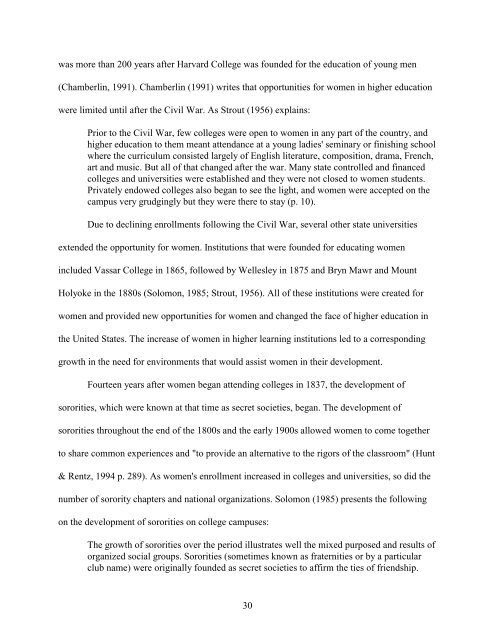Sorority Rituals - Reflections On Rites of ... - Mari Ann Callais
Sorority Rituals - Reflections On Rites of ... - Mari Ann Callais
Sorority Rituals - Reflections On Rites of ... - Mari Ann Callais
You also want an ePaper? Increase the reach of your titles
YUMPU automatically turns print PDFs into web optimized ePapers that Google loves.
was more than 200 years after Harvard College was founded for the education <strong>of</strong> young men<br />
(Chamberlin, 1991). Chamberlin (1991) writes that opportunities for women in higher education<br />
were limited until after the Civil War. As Strout (1956) explains:<br />
Prior to the Civil War, few colleges were open to women in any part <strong>of</strong> the country, and<br />
higher education to them meant attendance at a young ladies' seminary or finishing school<br />
where the curriculum consisted largely <strong>of</strong> English literature, composition, drama, French,<br />
art and music. But all <strong>of</strong> that changed after the war. Many state controlled and financed<br />
colleges and universities were established and they were not closed to women students.<br />
Privately endowed colleges also began to see the light, and women were accepted on the<br />
campus very grudgingly but they were there to stay (p. 10).<br />
Due to declining enrollments following the Civil War, several other state universities<br />
extended the opportunity for women. Institutions that were founded for educating women<br />
included Vassar College in 1865, followed by Wellesley in 1875 and Bryn Mawr and Mount<br />
Holyoke in the 1880s (Solomon, 1985; Strout, 1956). All <strong>of</strong> these institutions were created for<br />
women and provided new opportunities for women and changed the face <strong>of</strong> higher education in<br />
the United States. The increase <strong>of</strong> women in higher learning institutions led to a corresponding<br />
growth in the need for environments that would assist women in their development.<br />
Fourteen years after women began attending colleges in 1837, the development <strong>of</strong><br />
sororities, which were known at that time as secret societies, began. The development <strong>of</strong><br />
sororities throughout the end <strong>of</strong> the 1800s and the early 1900s allowed women to come together<br />
to share common experiences and "to provide an alternative to the rigors <strong>of</strong> the classroom" (Hunt<br />
& Rentz, 1994 p. 289). As women's enrollment increased in colleges and universities, so did the<br />
number <strong>of</strong> sorority chapters and national organizations. Solomon (1985) presents the following<br />
on the development <strong>of</strong> sororities on college campuses:<br />
The growth <strong>of</strong> sororities over the period illustrates well the mixed purposed and results <strong>of</strong><br />
organized social groups. Sororities (sometimes known as fraternities or by a particular<br />
club name) were originally founded as secret societies to affirm the ties <strong>of</strong> friendship.<br />
30



